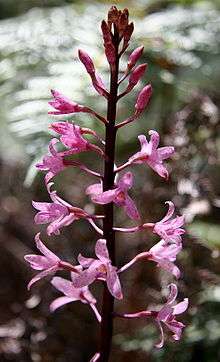Dipodium roseum
Dipodium roseum, commonly known as rosy hyacinth-orchid[3] or pink hyacinth-orchid,[4] is a leafless saprophytic orchid found in east and south-eastern Australia. In summer it produces a tall flowering stem with up to fifty pale pink flowers with small, dark red spots. A widespread and common species it is often confused with D. punctatum but has darker, less heavily spotted flowers.
| Rosy hyacinth orchid | |
|---|---|
 | |
| Dipodium roseum in Great Otway National Park | |
| Scientific classification | |
| Kingdom: | Plantae |
| Clade: | Tracheophytes |
| Clade: | Angiosperms |
| Clade: | Monocots |
| Order: | Asparagales |
| Family: | Orchidaceae |
| Subfamily: | Epidendroideae |
| Genus: | Dipodium |
| Species: | D. roseum |
| Binomial name | |
| Dipodium roseum | |
Description
Dipodium roseum is a leafless, tuberous, perennial, mycoheterotrophic herb. Between fifteen and fifty pale pink flowers with small dark red spots and 20–30 mm (0.8–1 in) wide are borne on a green to dark reddish black flowering stem 40–100 cm (20–40 in) tall. The sepals and petals are linear to elliptic, 13–20 mm (0.5–0.8 in) long, 3–6 mm (0.1–0.2 in) wide and free from each other with their tips curved backwards. The labellum is pink with dark lines, 10–15 mm (0.4–0.6 in) long, 4–6.5 mm (0.2–0.3 in) wide and has three lobes with their tips turned upwards. The centre lobe has a broad band of pink to mauve hairs. A rare white-flowering form also exists. Flowering occurs from November to February.[3][5][6][7]
This orchid is often confused with D. punctatum but has a broader band of labellum hairs, smaller dark red spots and more recurved sepals and petals.[6]
Taxonomy and naming
Dipodium roseum was first formally described in 1991 by David Jones and Mark Clements and the description was published in Australian Orchid Research. The type specimen was collected in Montrose in Victoria's Dandenong Ranges.[1][8] The specific epithet (roseum) is a Latin word meaning "rose-coloured",[9] referring to the colour of the flowers of this orchid.[8] The species was previously included in a wider circumscription of Dipodium punctatum.[1][6]
Distribution and habitat
The rosy hyacinth orchid grows in a range of habitats from dry woodland to wet forests. It occurs in Queensland south from Gympie, on the coast and ranges of New South Wales and the Australian Capital Territory and in most of Australia where it is the most common Dipodium. It is also found in the south-east of South Australia and is the only member of the genus to occur in Tasmania.[3][5][6][10]
Ecology
Pollination of this species, as for all species in the genus, is by native bees and wasps.[3]:270
Cultivation
No leafless species of Dipodium has been sustained in cultivation due to the inability to replicate its association with mycorrhizal fungi in a horticultural context.[3]:270
References
- "Dipodium roseum". APNI. Retrieved 13 July 2018.
- "Dipodium roseum M.A.Clem. & D.L.Jones". The Plant List version 1.1. Retrieved 24 January 2014.
- Jones, David L. (2006). A complete guide to native orchids of Australia including the island territories. Frenchs Forest, N.S.W.: New Holland. pp. 272–273. ISBN 1877069124.
- Bishop, Tony (2000). Field guide to the orchids of New South Wales and Victoria (2nd ed.). Sydney: UNSW Press. pp. 199–200. ISBN 0868407062.
- Weston, Peter H. "Dipodium punctatum". Royal Botanic Garden Sydney. Retrieved 13 July 2018.
- Jeanes, Jeff. "Dipodium roseum". Royal Botanic Gardens Victoria. Retrieved 13 July 2018.
- "Dipodium roseum". Yarra Ranges Local Plant Directory. Yarra Ranges Shire Council.
- Jones, David L. (1991). "New taxa of Australian Orchidaceae". Australian Orchid Research. 2: 51.
- Brown, Roland Wilbur (1956). The Composition of Scientific Words. Washington, D.C.: Smithsonian Institution Press. p. 651.
- Jones, David L. (1998). "Contributions to Tasmanian Orchidology". Australian Orchid Research. 3: 206.